Please find below an update detailing the status of the five Vermont Phosphorus Innovation Challenge (VPIC) Participants engaged in Stage Three agreements, awarded in November of 2019.
February, 2020 | Montpelier, VT - The progress and results of all VPIC projects has been substantially impacted by the Covid-19 pandemic, posing many hurdles with availability of labs for research and trials, delays impeding access and delivery of equipment, and pauses in fabrication of equipment and technology due to Stay Home orders and social distancing guidelines. The dedication and progress displayed by all groups has been nothing short of impressive.
DVO, Inc.
During Stage Three, DVO has engaged in two different studies to explore methods of drying materials produced from anaerobic digesters at dairy farms, to then be enhanced using a Dissolved Air Floatation Device (DAF) process capturing valuable nutrients for advanced solids control. The goal of the project is to develop a ‘P-Cake’ product that is high in phosphorus and other nutrients. This material can then be processed, bagged and/or bottled as a marketable retail product, in addition to being used to create, sell, and distribute bulk fertilizer and soil amendment materials from a facility established in Vermont.
The remaining hurdle for DVO in full execution of their proposal is perfecting a drying method for the materials produced from the DAF solids. DVO had initially proposed the use of quicklime (QL) as an additive to decrease moisture in the products without impacting growth or germination rates. Unfortunately, this method – while adequately drying the material, did impact growth yields due to changes in pH, as well as biding up nutrients and making them unavailable to plants. The second drying method, the use of a centrifuge to dewater the DAF solids to a level that is manageable without incurring substantial nutrient losses from the solids, concluded in December of 2020. The method was not deemed a viable option for drying the DAF material as the moisture content attained through the Centrifuge process was too high, resulting in a product that had unimpacted growth impacts, but was still too wet to manage and process into a bagged product.
Currently, DVO is exploring the use of a ring dryer to decrease the moisture content of the materials such that it can be managed and processed. The logistics and operating costs of this equipment are being explored and will be submitted to the VPIC Leadership Team by the end of February 2021 in a report format. The VPIC Leadership Team will review this report to determine the release of the remaining funding awarded to DVO, Inc through VPIC Stage Three. These results will be documented in a subsequent update.
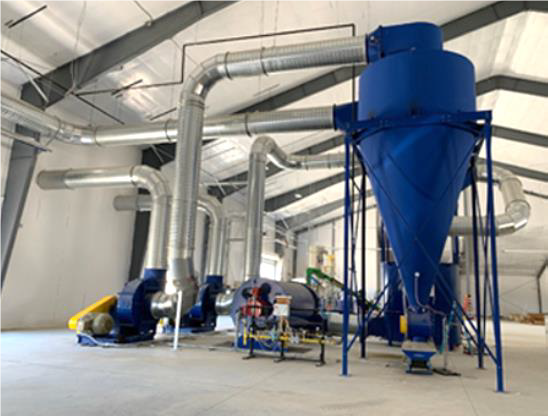
IEC-Thermo Ring Dryer Configuration (DVO Photo)
Green State Biochar
Green State Biochar (GSB), a producer of enriched biochar, has been actively working on honing their biochar filter design to meet reduction efficiencies that would indicate the effectiveness of prototypes, such that these practices might be used or recommended by VAAFM engineers as a solution to varying water quality or nutrient management concerns located on farm operations. To do this, VAAFM engineering personnel, worked with GSB, and the Center for an Agricultural Economy, to design a field trial that would indicate the reduction capacity of biochar as it relates to a similar, cheaper, and accessible media commonly used in filtration practices, septic sand. The biochar, after being used as a filtration media, is then enriched with nutrients, allowing farmers to use this product as an additive on nutrient deficient fields, or for GSB to buy back and resell as a nutrient additive for other farmers or gardeners. This second step is important to consider, as sand does not have the ability to be reused in such a way.
Simultaneously, GSB contracted with Atlantic Corporation of Waterville, Maine to explore the market demand for GSB’s enriched biochar products in a Market Research Report. The Market Research Report found that there is substantial interest in phosphorus enriched biochar, however retailers currently have little knowledge on or about this product. With several recommendations from Atlantic Corporation generated through a Business to Business survey, there seems to be a meaningful potential for market growth.
GSB also submitted a Research Report documenting the results of the research trial. The report indicated that while there exists a significant potential use for biochar as a filtration media for on farm agricultural waste, concerns persist regarding the design and implementation of a filtration mechanism that will consistently, effectively operate without malfunction. The VPIC Leadership Team determined that further research and trial runs are needed to hone and fine tune such a design before widespread implementation on farms can occur with direct financial support from the State of Vermont Best Management Practices (BMP) Program. These concerns, in addition to the recommendation from the VAAFM engineer involved with coordination of the field research trial, to not recommend biochar as a phosphorus removal media for agricultural waste streams, led the VPIC Leadership Team to the decision to not allocate additional funding to Green State Biochar for further implementation of VPIC Stage Three. The decision was communicated to GSB on January 27, 2021.
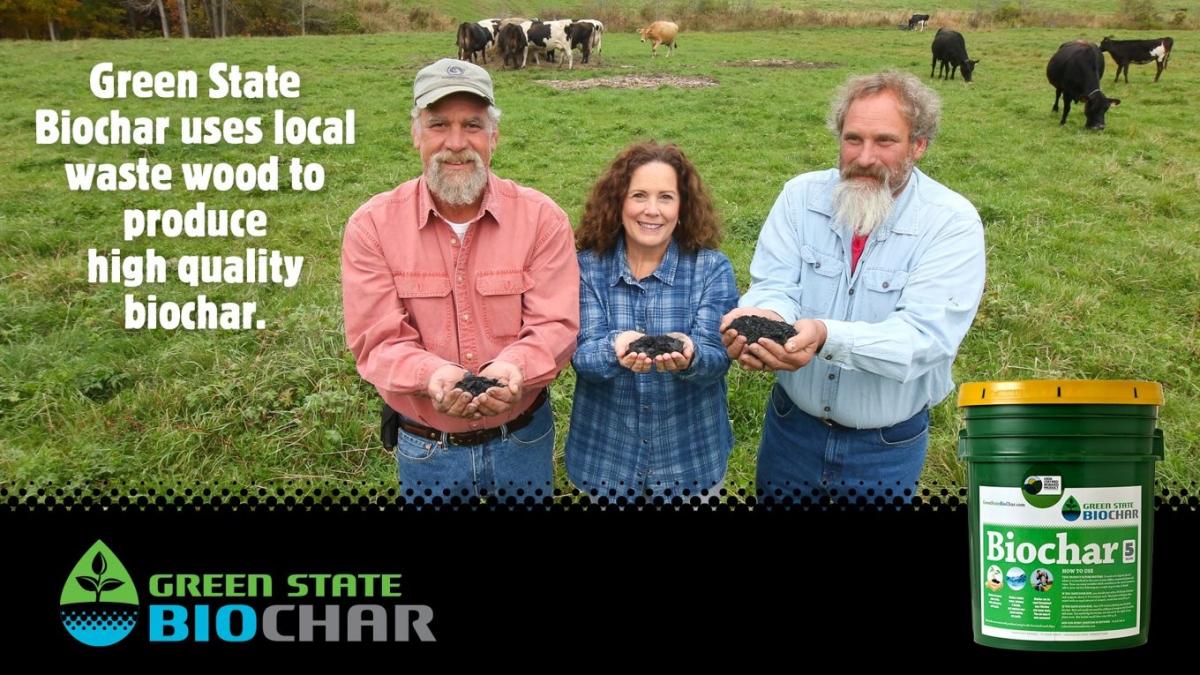
Green State Biochar Team (GSB Photo)
Digested Organics
Digested Organics has been engaged in the fabrication and construction of a mobile manure screening and ultrafiltration system to be used on a Vermont dairy farm to remove >95% of the phosphorus, >99% of the suspended solids, and >99.9% of pathogens in liquid manure, the UF System. The remaining liquid is ideal for field application (80% of the initial manure volume) and the concentrated fertilizer is readily transportable (20% of the initial manure volume). By concentrating phosphorus, this technology allows the farm to apply phosphorus more economically on lands that are further away and typically lower in soil phosphorus, as well as transport the material to nearby compost facilities for stabilization and incorporation into value-added products.
The design for the UF System is complete, as is the fabrication of the UF module. This system can process about 3,000 GPD of manure (about 100 cows) and generate around 2,000 GPD of permeate. The permeate will flow by gravity to a nearby storage lagoon and the concentrate will be collected in a tank at the site, where it will then be transferred to the composting operation run by Agrilab Technologies (another VPIC Participant). The 20’ trailer transporting this equipment has been completed and is scheduled to be delivered to Vermont by late March, later than expected due to further delays caused by Covid-19.
The biggest open item for this VPIC Project is regarding electrical service needs, specifically 3-phase power. 3-phase power is needed first of all for the Digested Organics’ UF units, with some of the pump motors for that equipment package being up to 15 hp. 3-phase power is also beneficial for operating the screw press separator and Agrilab Technologies’ CAHR unit. This open item is still being explored, and it is likely to dictate on which farms Digested Organics will be able to operate the UF Unit. Establishing 3-phase power can be exceeding expensive, so likely Digested Organics will initially be working with operations that have existing 3-phase power capabilities. Updates on this topic will be provided in in a subsequent update.
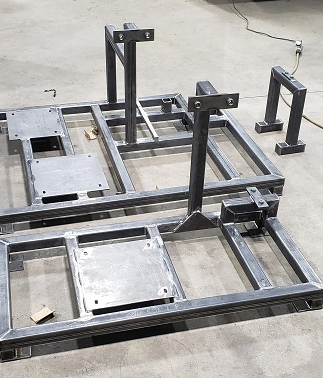
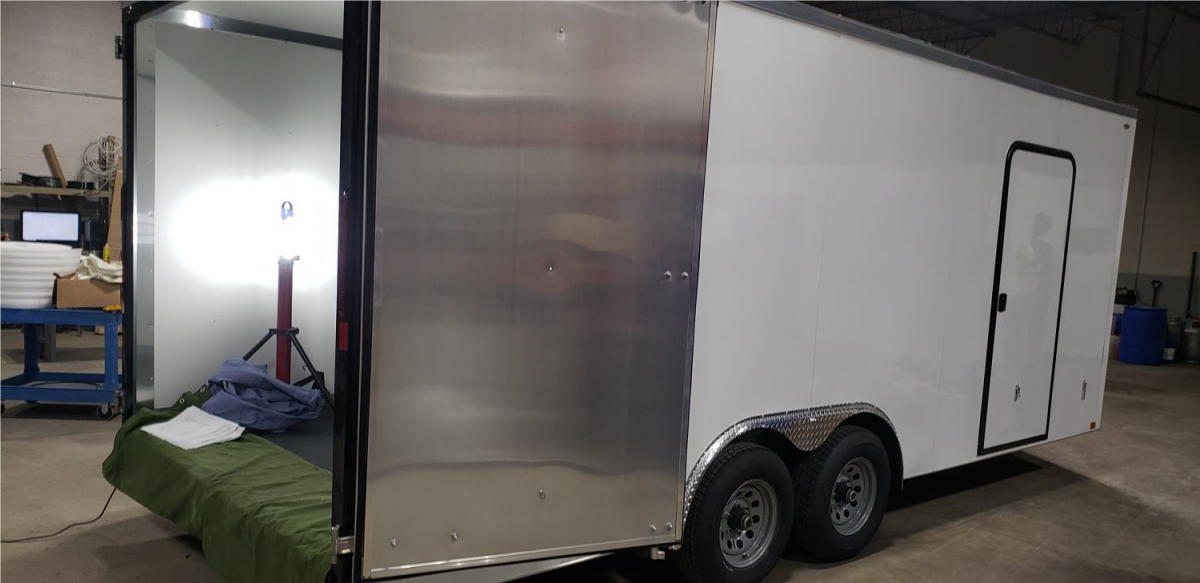
Structural steel components being welded to support the UF modules and pumps// Trailer for transporting UF modules and pumps (Digested Organics Photo)
Agrilab Technologies Inc.
Agrilab Technologies Inc.’s (AGT) Stage Three VPIC proposal includes the establishment of a hub and spoke network of five on-farm composting and phosphorus processing sites. AGT has been engaged in establishing the market demand for composted materials created from cow manure, with various combinations of nutrient additives. AGT worked closely with the Vermont Sustainable Jobs Fund (VSJF) to document the demand for bulk and bagged products, as well as willingness to pay for locally produced fertilized for use by Vermont farmers, in home gardens, specialty crop growers, etc. A required Market Research report documenting the demand and market potential for these products was submitted by AGT in March of 2020. Similar to DVO and GSB, AGT was initially awarded $25,000.00 to conduct this research to determine if further development of this market was viable, and if the total grant award was to be released. On April 20, 2020 AGT was notified by the VPIC Project Manager of the acceptance of their Market Research Report, releasing the remaining of $305,200.00 awarded to AGT through VPIC Stage Three for the establishment of infrastructure necessary to support the hub and spoke model.
AGT has been working on equipment fabrication, site development tasks, and additional business planning. Equipment fabrication specifically involves the ordering of components and assembly of the AGT Compost Hot Box 250-8R. This equipment package has been mounted inside an insulated 20’ shipping container at the company shop in Cambridge, VT. This equipment package is the compost aeration and heat recovery (CAHR) unit that will be able to produce compost from phosphorus (P) containing ingredients including livestock manure (separated dairy manure solids, scraped manure and pen manure), wood chips, leaves, sawdust, waste feed, and P concentrate (from a Digested Organics LLC ultrafiltration unit). The unit can be monitored and controlled remotely in order to reduce on-site labor demands and optimize operation. Fabrication was completed and the unit was transferred to the Magnan Brothers Dairy LLC, Burnor Farm on January 22, 2021.
Site development tasks have been focused on work with the Magnan Brothers Dairy LLC, their Burnor Farm will be the ‘hub’ of the model. Four different farmsteads in Fairfield and St. Albans that house either lactating dairy cows or heifers are being explored as potential ‘spokes’ for the model. Physical space available, availability of power and internet, characteristics and volume of manure at the farmstead and suitability for other value-added processing and/or retail activities were assessed for the Chester Arthur “home” farm, Maquam Shore Dairy “bay” farm, Burnor Farm, and Stonehouse Farm.
The VPIC Leadership Team visited the AGT Cambridge shop (both physically and virtually) to see the Compost Hot Box unit prior to its move to the Magnan Brother Dairy Burnor Farm. The timeline for product testing in 2021 with a targeted spring 2022 launch is still on track with the submitted marketing and business plan.
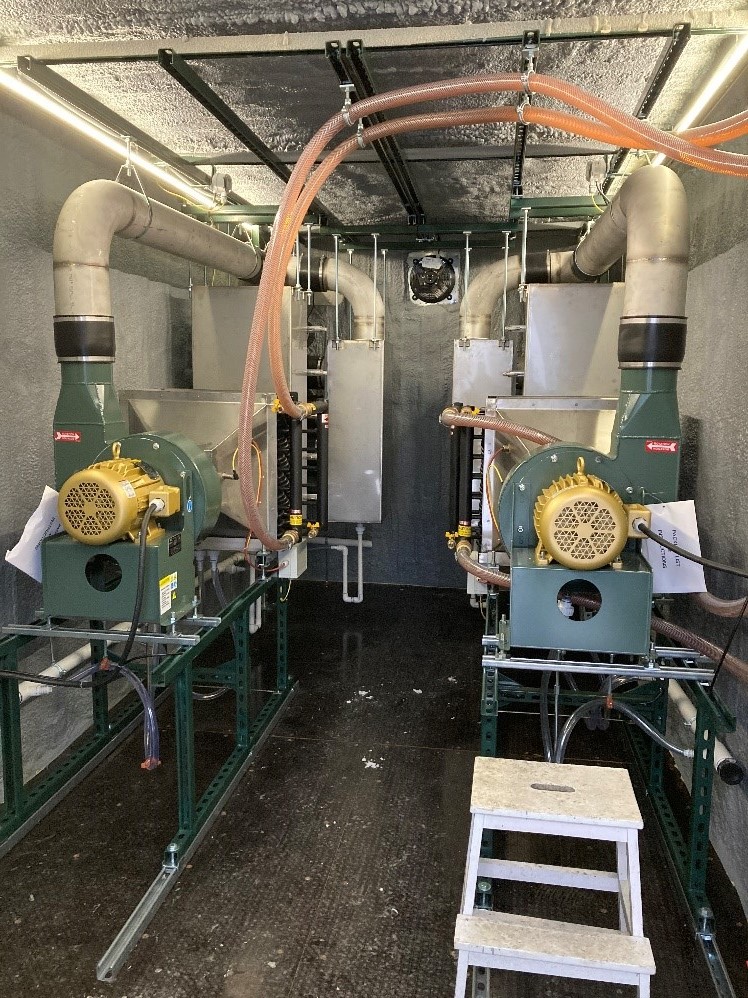
Agrilab Technologies Compost Hot Box (AGT Photo)
University of Vermont and Village of Essex Junction
The University of Vermont and the Village of Essex Junction, along with several other partners have developed and been testing Pe −Phlo (pronounced P Flow), a mobile, flexible, and scalable solution for Phosphorus capture and removal. Pe −Phlo applications focus on reduced installation and operational costs without the investment needed for conventional Phosphorus removal “brick and mortar” approaches. Proprietary pipe descaling technology (PDT) is widely used throughout the United States in thousands of successful scale formation control applications. This technology may well prove cost effective for Phosphorus removal in Vermont sized wastewater applications. The technology induces an oscillating electric field of variable amplitude and specific frequency that promotes formation and precipitation of crystalline minerals (i.e. Struvite) without dangerous and damaging adhesion normally associated with the formation of these compounds. Pe −Phlo uses PDT coupled with an electric-filtration membrane filtration cell, to enhance Phosphorus capture and removal from the waste stream.
Struvite generation systems are employed to remove Phosphorus from waste streams originating from water resource recovery facilities. The new Pe−Phlo System allows for controlled formation and removal of Struvite and Vivianite outside of the treatment process. The collected Struvite can be processed as a fertilizer resource outside of the wastewater facility. Pe−Phlo is viable on a small-scale application because it uses an innovative application of pipeline descaling technology as a means of enhancing crystalline Struvite generation and Phosphorus removal. It also uses a proprietary electrical field on the filter that allows for efficient capture of the Struvite crystals generated. Pe−Phlo enhanced Struvite generation and capture improves the scalability to Vermont-sized water resource recovery facilities and Vermont sized farms. UVM has been continuing trials documenting the scalability of Pe −Phlo. The research was severely impacted with the shutdown of the UVM lab during the spring and early summer of 2020.
Construction of the PePhlo reactor designed during the capstone project remains in process, although still is experiencing delays due to Covid-19. The research on branding, market niche as well as competitive equipment and process identification will serve well for further work on a business plan as pilot work continues. The Final Report due date for this project has been extended to March 8, 2021 and will be addressed in in a subsequent update.

Essex Junction Wastewater Treatment Facility (Village of Essex Junction Photo)

